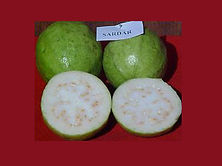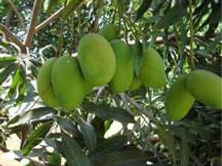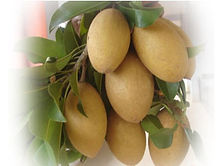Crop Production

Banana
-
Studies on organic production of banana indicated that treatment combination of FYM (10 kg/plant) + neem cake (1.2 kg/plant) + vermicompost (5 kg/plant) and wood ash (1.75 kg/plant) + triple green manuring with sunhemp (Coimbatore) or Diancha (Jorhat) + double intercropping of cowpea + bio-fertilizers, viz., Vesicular Arbuscular Mycorrhizae (25 g/plant), Azospirillum (50 g/plant), phosphate solubilizing bacteria (50 g/plant) and Trichoderma harzianum (50 g/plant) was effective in registering the higher bunch weight of banana at Coimbatore and Jorhat.
-
Studies on the epidemiology of Sigatoka leaf spot indicated that, youngest leaf spotted (YLS) a measure of the number of leaves free from infection was highest in July and August plantings at Arabhavi, in June and August plantings at Kovvur, in March to May plantings at Bhubaneswar and in May to July plantings at Jalgaon.

Citrus
-
Soil application of 25 kg FYM + 5 kg neem cake + multiple microbial culture of NRCC (T. harzianum, Pseudomonas fluroscens and Azotobacter/ Azospirillum) + 50% recommended dose of fertilizers - RDF (comprising FeSO4, MnSO4 and ZnSO4 200g/plant) as soil application + 50% RDF (comprising FeSO4, MnSO4 and ZnSO4 200 g/plant each) as foliar application has shown better vegetative and yield attributes of Nagpur mandarins.
-
Foliar application of Bacillus thuringiensis (0.1%) or Beauveria bassiana @ 4X106cfu/ml (0.1%) at pest initiation period was effective in the management of lemon butterfly upto 14 days after spray and are comparable with the chemical pesticides (carbaryl). The next best alternatives include NSKE (5%) and neem oil (1%) in lemon butterfly management both on sweet orange and mandarins.
-
Among the different acaricides tested, abamectin 1.9 EC (0.0007%), ethion 50 EC (0.05%), propargite 57 EC (0.057%) are the three best treatments with highest B/C ratios followed by petroleum spray oil (2%) or neem oil (5%) both in economical as well as pest controlling aspects for the control of green (Eutetranychus spp., Schizotetranychus spp.) and rust mites (Phyllocoptruta oleivora) in sweet orange and mandarins.
-
For management of Phytophthora/gummosis, two application of Bordeaux paste (1:1:10) on trunk (pre/post monsoon) with soil application of Trichoderma harzianum+ Trichoderma viride + Pseudomonas fluorescens (100g each/plant) followed by Fosetyl-Al (Aliette) 0.2% spray, first at initiation of the disease and second one month after first application has been effective.

Guava
-
The var. Sardar performed well at Udaipur (20.7 kg/tree), Ludhiana (52.1 kg/tree) and Sangareddy (99.20 kg/tree).
-
Among 4 spacing tested, significantly the highest yield (11.4 t/ha) was obtained in the treatment 1.0 mx1.0 m followed by 2.0 mx1.0 m (8.0 t/ha).

Grapes
-
Evaluation of colour seedless varieties of grapes at Mandsaur has resulted in identification of a variety Kishmish Moldowsky with maximum yield per vine (1.72kg), highest weight of 100 berries (335.70g) and maximum acidity (0.62%). Maximum raisin recovery (%) was observed in Kishmish Chernyi (23.25) followed by Ruby Seedless (23.07).
-
The hybrids such as H-80 (James x Beauty seedless), H-181 (Concord x Cheemasahebi), H-222 (Anab-e-Shahi x Catawba), H-307 [H-541 (Khalili x Bhokri) x Sharad Seedless], H-384 (James x Sharad Seedless) showed better performance for bunch and berry weight and berry size, hence, selected for further evaluation.

Jackfruit
-
About 125 accessions of jackfruit have been collected and are being conserved in various centres such as Jorhat (18 accessions), Kannara (15 accessions), Kovvur (25 accessions), Mohanpur (35 accessions), Periyakulam (18 accessions) and Phalgar (16 accessions).
-
The inarching, epicotyl and softwood grafting on varying rootstock age were tried and found that inarching was more successful.

Litchi
-
Out of 34 litchi varieties evaluated, the var. Rose Scented was found promising with regard to tree vigour, fruit yield and quality followed by Calcutta, Early Bedana and Late Bedana under Tarai conditions of Uttarakhand.
-
Results of substrate dynamics treatments in litchi cv. Rose scented showed that application of ½ RDF + 50 kg FYM + 5 kg vermicompost was found effective for improving fruit yield (55.58 kg/tree), fruit weight (22.42g), TSS (21.160 B), ascorbic acid (30.20 mg/100g pulp), aril content (16.52g) as well as for reduced fruit drop (49.33 %) and cracking (7.07%).
-
The girdling of 50% of primary branches with 6mm level of girdling was found to promote the early flowering (3rd week of March), harvesting (4th week of June), improved fruit weight (28.33 g), total yield (137.83 kg/ tree) and TSS (19.8°B).

Mango
-
Evaluation of varieties have resulted in identification of the highest yielding (62.71 kg/tree) variety Bangalora and Dashehari (55.40 kg/tree) at Paria, while Mallika has recorded maximum yield (79.66 kg/tree) followed by Himsagar (75.63 kg/tree) at Mohanpur,
-
Among released hybrids, the Amrapali (71.76 kg/tree), Neelgoa (70.30 kg/tree) and Prabhashankar (64.90 kg/tree) registered highest yield at Mohanpur. At Pantnagar and Periyakulam, the variety Mallika performed better with the yield of 11.46 kg/tree and 54.85 kg/tree, respectively.
-
The double hedge row systems of planting continue to be superior for maximum yield at all centres. In case of rejuvenation of old orchards, thinning of crowded branchlets and centre opening of the tree after fruit harvest with standard dose of paclobutrazol application has registered the highest yield (405.52 kg/tree), TSS (21.30 °B), shelf life (17.10 days) and the least acidity (0.318 %) as compared to the control with yield of 140.80 kg per tree.
-
The observations on population dynamics of hoppers revealed that the hoppers were found to be very active throughout the year at Pantnagar, Sabour, Vengurle and Paria (except from May-August) but in Sangareddy and Mohanpur hoppers were occurred only in the months of January, February and March. The hanging of Rakshak trap with methyl eugenol lure @ 5 traps/ha and replacement of the lure at 2 months interval was found to be effective against fruit fly as compared to other treatments at Mohanpur and Vengurle.

Papaya
-
A total of 87 accessions including two wild relatives viz., Vasconcellea cauliflora and Vasconcellea goudotian are being maintained.
-
The treatment comprising spraying of acephate 1.5 g/l (3 days before planting) + Sesbania as border crop was found to significantly suppress the incidence of PRSV at 90 DAP (16.3% as against 24.3% in control). In addition to this, the growing of border crop + spraying of urea (10 g/l) + zinc sulphate (1.5 g/l) + boron (1.0 g/l) + yellow sticky trap (5/acre) recorded higher yield (50.8 kg/tree) as against in control (27.0 kg/tree). Similarly, December - February planted crop had the lowest (25%) incidence of PRSV during April.

Sapota
-
Planting spacing at 8mx4m (312plants/ha) recorded higher yield of 12.85 t/ha as against the yield of 5.96 t/ha in the 10mx10m spacing (100 plants/ha), number of fruits (680/tree), fruit yield (56kg/tree) and individual fruit weight (85.60g) in 9 year old plants.
-
Studies on effect of organic and inorganic fertilizers in sapota showed that the combination of vermicompost (10kg) + 750:300:400 g N, P2O5, K2O per tree per year respectively recorded more tree height, spread, number of fruits, mean fruit weight, yield and TSS at Periyakulam.
